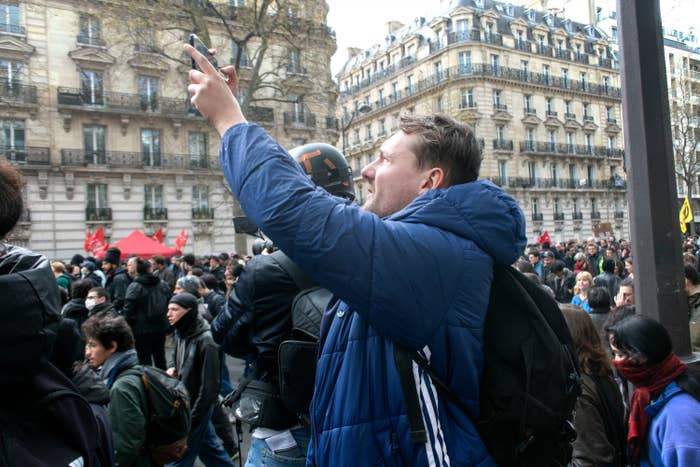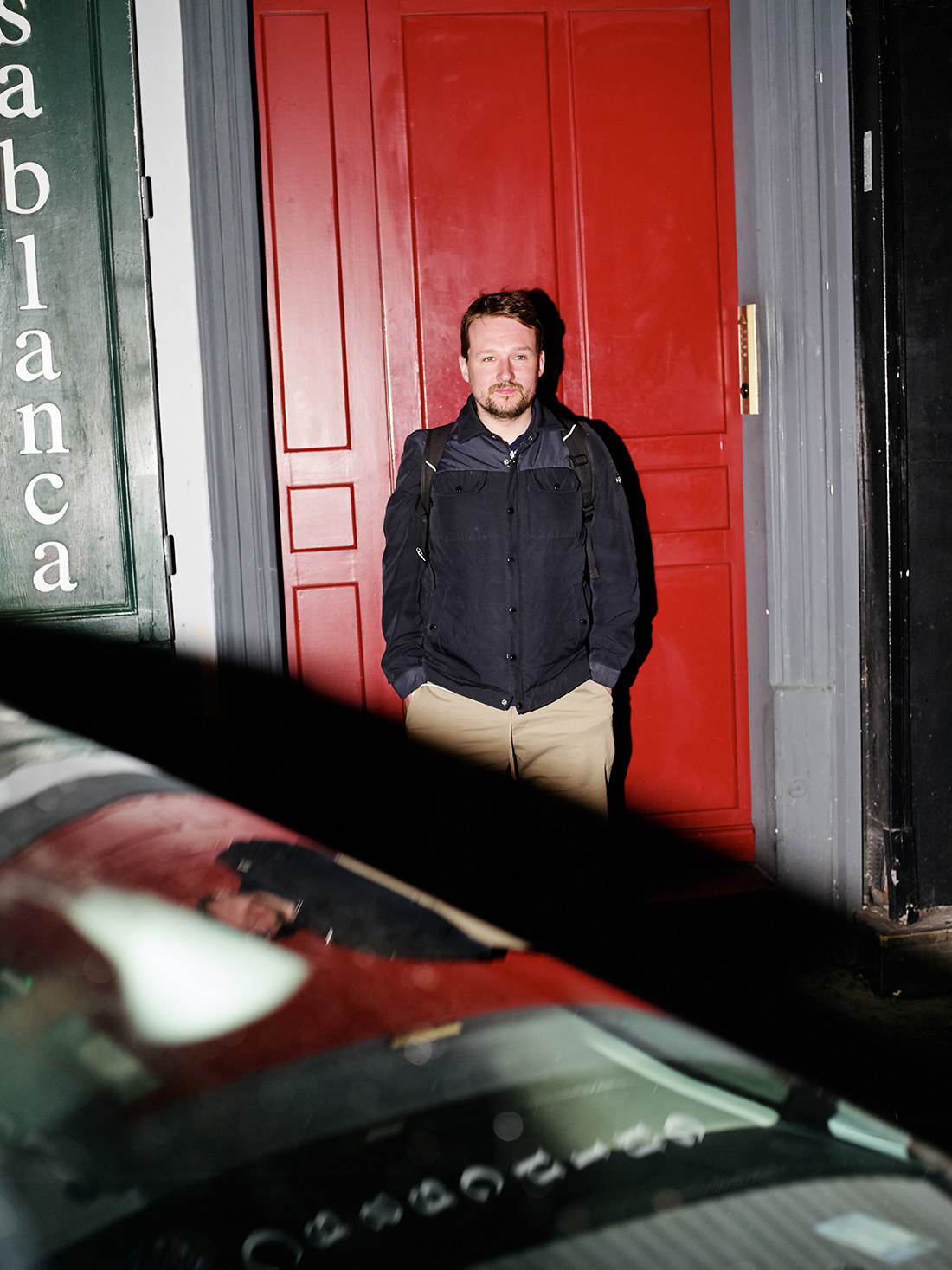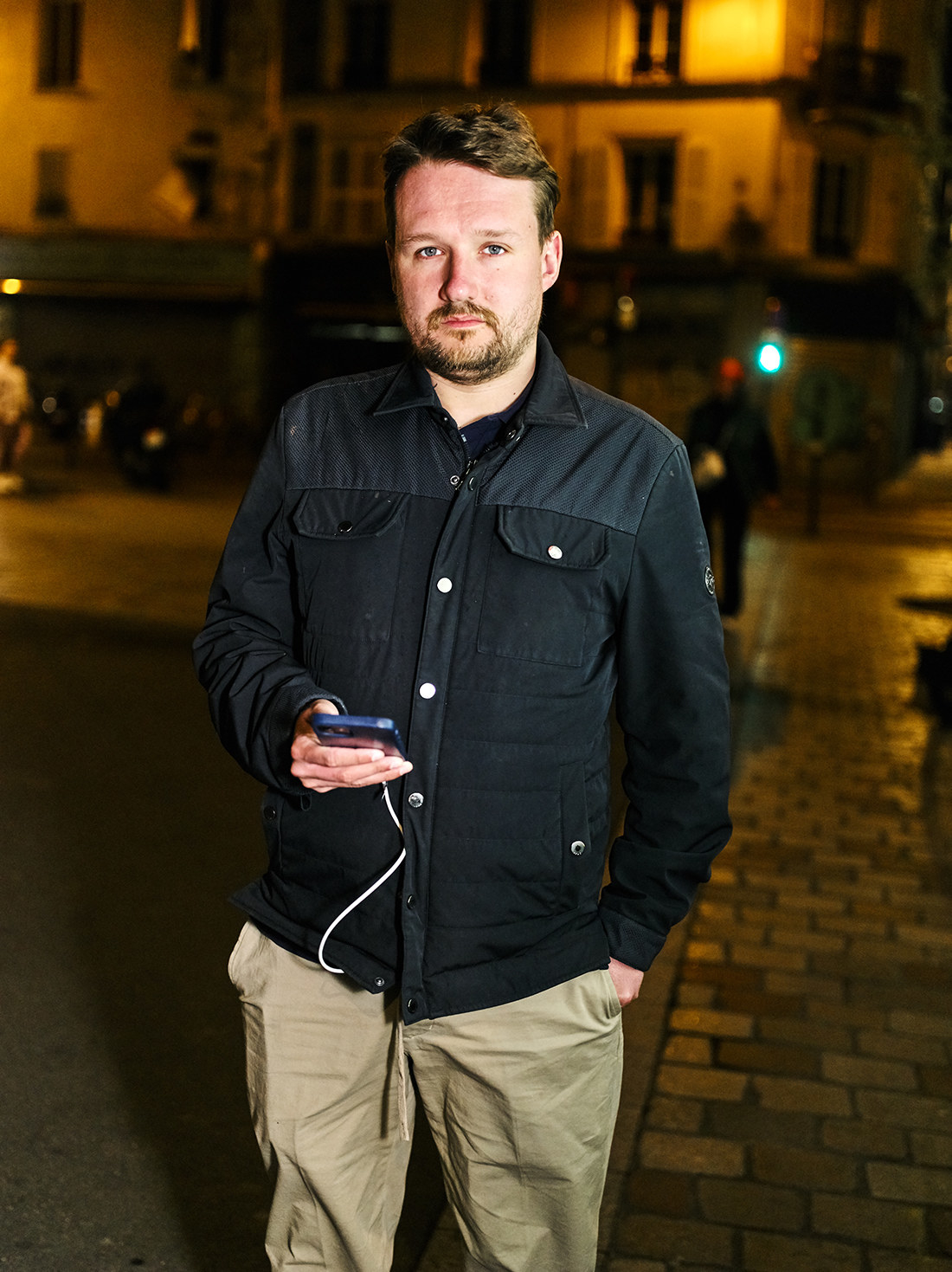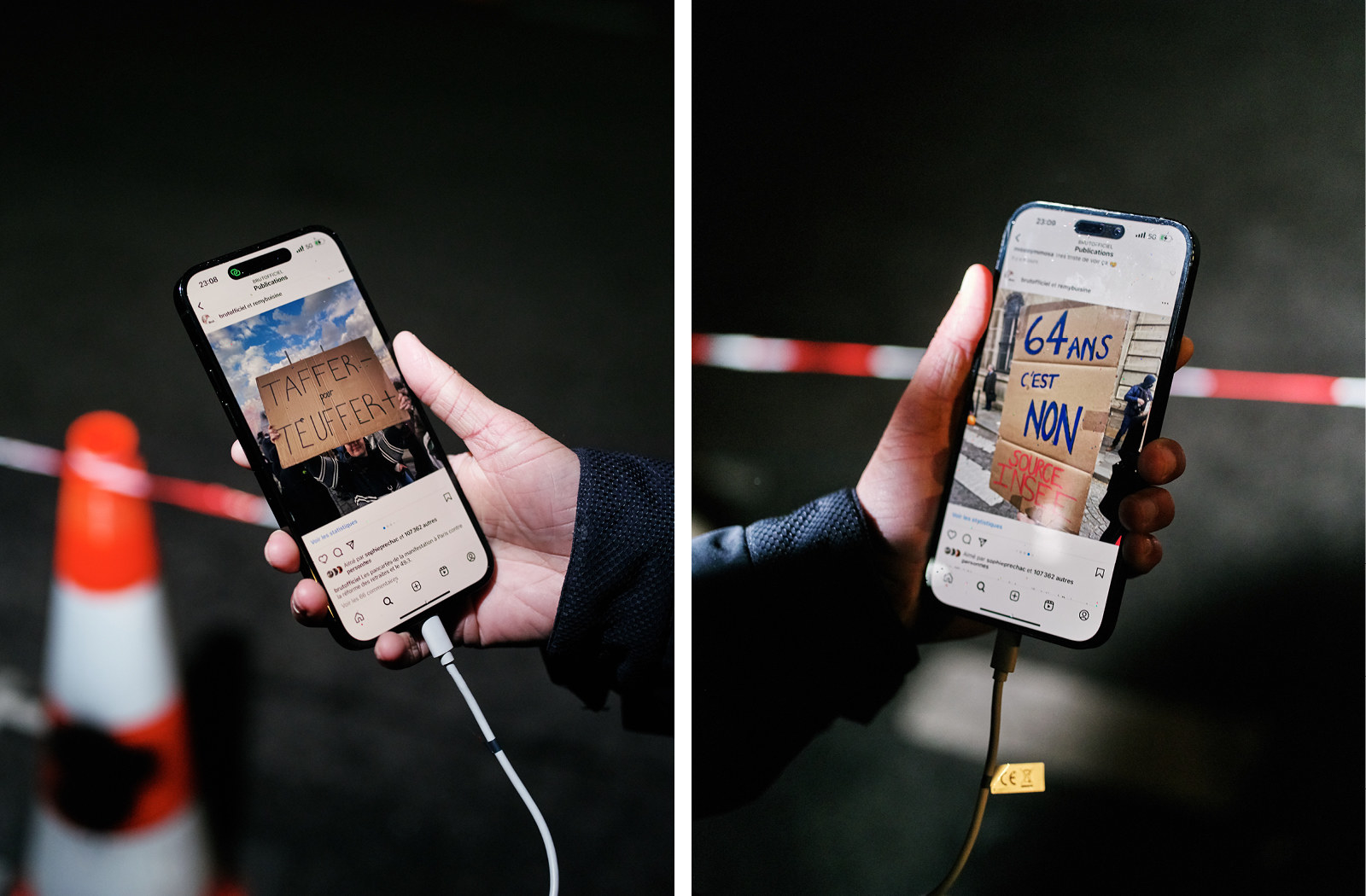PARIS — The April 6 protest had already been moving for half an hour by the time I found Rémy Buisine. The 32-year-old video journalist at French online media outlet Brut had given me his live location, but he wasn’t wearing his neon-yellow press armband yet and, given his outfit (a light, navy puffer jacket and blue jeans), he blended right in with the crowd — which was anywhere from 57,000 to 400,000 people, depending on whether you believe the police or union organizers. Buisine found me, in fact: He yelled out my name with a smile on his face, before getting back to business, instructing a colleague to go shoot the back of the march.
Buisine has become, for millions of people worldwide, the eye into the recent French protests. The demonstrations were originally about pension reforms proposed by President Emmanuel Macron in January — the main sticking point was the potential increase of the minimum retirement age from 62 to 64 — and the first marches were largely made up of union-faithful, middle-aged people. However, on March 16, when the government forced the reform bill through without a vote, more than 6,000 people showed up, without formal planning, at Paris’s Place de la Concorde. That crowd, mainly under age 30, were outraged by what they saw as the government’s anti-democratic actions.
Almost nightly, for the next two weeks, French people gathered on the streets in what the media called “spontaneous” or “wild” protests. “I saw lots of young people show up,” Buisine said, “and many, still, who had never set foot in a protest.”
Buisine’s livestreams from the demonstrations’ teargassed frontlines have lasted up to eight hours, with 70,000 people tuning in to Brut’s TikTok at the height of a stream. Over the last month, the outlet’s TikTok has gained a million followers — it now has 4.2 million — thanks in large part to his streams. (Buisine also broadcasts on Facebook and the Brut app.) And his reach is international: Fans constantly call for him to speak English, but Buisine doesn’t know how to say much beyond that he is broadcasting “live in Paris.”
As we walked to the front of the day’s demonstration, Buisine used one of his two phones (one business, one personal) to take pictures of protesters’ signs for the Brut Instagram account. In the half hour we’d been together, six fans or peers came to say hi, including a volunteer medic who asked Buisine when he’d start his broadcast. “Soon, soon,” Buisine said, stopping only momentarily.

Outside Montparnasse station, near the Brut offices, Buisine paused to pull hermetically sealed goggles and a gas mask out of his backpack. He put the goggles into his right outer jacket pocket, and looped his gas mask over his neck. He had tear gas decontaminant spray in another jacket pocket.
At 3:29 p.m., a few hundred feet down the boulevard, we heard a loud bang — source unknown. The protesters cheered and jeered back, yelling “ACAB” (though the crowd’s French accents made it sound like “ah-caaaaah-buh”). As we made our way to the front zone, a bunch of young people, dressed completely in black and masked up, lounged next to an exit of the Vavin metro station. A few feet ahead, next to Café de la Rotonde, gendarmerie — a military force — lined the width of the boulevard with their riot shields up.
At 3:37 p.m., the gendarmerie blasted an unmistakable warning shot. The crowd tensed up; as some protesters retreated, Buisine pushed his way forward. He had his phone out and was recording video, though not livestreaming yet. Two or three more warning shots rang out quickly. Black-clad figures — the youth from before — materialized at the frontline. One banged a metal barricade on the road as he moved up. Buisine and I locked eyes: It was time for me to go.
As agreed beforehand, I was to leave at the first sign of trouble. When Buisine films, he focuses on police action and is known to run toward it — and I did not have the protections afforded by equipment or a press card. I turned around as I pushed through the crowd; Buisine had put his bag down and was taking his helmet out.
Less than a minute later, the first tear gas canister was launched into the crowd. Buisine was already busy streaming.

“It’s the job of my dreams,” Buisine said, referring to being a journalist, in an interview at Brut’s Paris office the week before. Growing up in a village in France’s northeast, Buisine didn’t know anyone in journalism and didn’t test well at school, which precluded him from getting into a good university. So after graduating from a horticultural technical high school, he got a job managing soccer players’ social media. Still, he yearned to be a journalist, and to do that, he had to move to Paris.
Buisine arrived in the city in August 2013, after landing a job as a community manager for Parisian radio stations. It wasn’t journalism yet, but it was a step in the right direction.
In 2015, he embraced the then-new livestreaming app Periscope, using it to stream the protests against the El Khomri labor laws — which made it easier for companies to lay off workers — in his spare time. Buisine got his training on the ground, learning what people wanted to see based on their reactions to his livestreams, and how to go about reporting by asking the established journalists also covering the protests.
Although he still didn’t consider himself a journalist, his livestreams got traction and resulted in his being hired as a founding member of Brut in 2016. At the beginning, the French establishment had absolutely no idea what to make of Brut, as it existed solely on social media platforms. “Some politicians were chilly about coming on Brut,” Buisine says, “because they were scared of communicating on social media.” However, in 2020, Buisine led a two-and-a-half-hour livestreamed interview with Macron.
Buisine has gained a large fanbase, most of them young people who are Extremely Online like him. Part of his appeal is that he’s willing to really listen. Prominent protester Ritchy Thibault, 18, told BuzzFeed News that he admired Buisine because “he gives time to people on the street to talk for 10, 20 minutes, interviewing them at length as to why they’re protesting.”

Viewers are also drawn in by the fact that Buisine is risking life and limb. Like other journalists covering protests, Buisine has encountered his fair share of police violence, being not just teargassed, but also truncheoned, despite laws set up to protect members of the press. Any time Buisine is being attacked, the number of viewers skyrockets. After, he reads the comments and tells everyone he’s fine, even when he clearly isn’t.
These protests have been less traumatic than others he’s reported on though. Buisine recounted to me seeing “horrible things” during the Giets Jaunes (“yellow vests”) protests that started in 2018: “hurt people, open skulls, people who’d lost an eye, people next to you whose lives have been upturned because they lost a hand.”
Though livestreaming protests can be emotionally draining, one reason why Buisine prefers the medium is because “it’s only through that format that you can talk about the essence of the movement.” In the stories of protesters asking to not be cast aside by the government, he hears the concerns of those he knew growing up in the rural, working-class world.
He’s always on call. “I dedicate myself to my work,” Buisine said. “I give a lot of my energy into it, I don’t keep track of the hours I work.” He said his life is pretty much his job — he’s single, has no children, and lives alone (viewers continually comment “a girlfriend for Rémy”). “At Brut, they know if I’m needed, I’ll be there. So I go.”

After I left him, Buisine filmed some protesters breaking into a building — a resident had thrown something at them — and he captured the Café de la Rotonde’s awning going up in flames. For about half an hour, he was stuck inside a battered bank surrounded by police. Later on, at what seemed like the end of the protest, at Place d’Italie, he stayed for hours with the last, defiant protesters who’d been kettled by police at the entrance to the metro station. At one point, the protesters sang in his honor: “Ah Rémy, allez, allez, allez!”
The police eventually released those remaining, who headed south down Avenue d’Italie. Near the Tolbiac metro station, they pulled garbage bins across the road and set fire to wood, forming a barricade. Three deputies (the French equivalent of a member of the US House of Representatives) appeared, not wearing their official tricolor sashes. Two of them did five-minute interviews with Buisine.
Buisine then headed back down the road, toward the barricade, for a final summary of the events that led to this protest. He reminded viewers, for the umpteenth time that day, to follow the channel and to turn on notifications for when he goes live. He thanked new followers by name. At 10:54 p.m., after seven and a half hours and more than 28,000 steps, he ended the livestream. Some 1.8 million people had watched on TikTok alone.
I found Buisine just after: He was filming the nearby raging fire on his phone, not quite done for the night. A protester approached and asked Buisine if he was tired. “I’m fine,” Buisine responded. Some of his friends joined him. He was still filming when a protester yelled, “They’re coming!” At that point, a tear gas canister flew toward us, its sparks shooting against the dark.

It took 40 minutes for Buisine’s friends to convince him to go to a nearby kebab restaurant. He ordered a döner kebab meal, but left the chips, rice, and salad on his plate. (He said he can’t eat or drink much after breathing in so much tear gas.) Though surrounded by friends and peers, he continued to post clips of the protest to Instagram and TikTok.
We left the restaurant after 1 a.m., but Buisine wouldn’t get to sleep until 3 or 4 in the morning as his body was still coursing with adrenaline. “Sometimes I sit down, eat, and can’t get back up without falling back down,” Buisine said, “but I can’t sleep.”
Nonetheless, he had to be up at 9:30 a.m. the next day to run an editorial meeting — he’s also Brut’s head of short-form content. On Saturday, he would get his first full day off in three weeks, before a building collapsed after an explosion in the city of Marseilles. He’d pack up, travel there by train, and start livestreaming once again. ●

